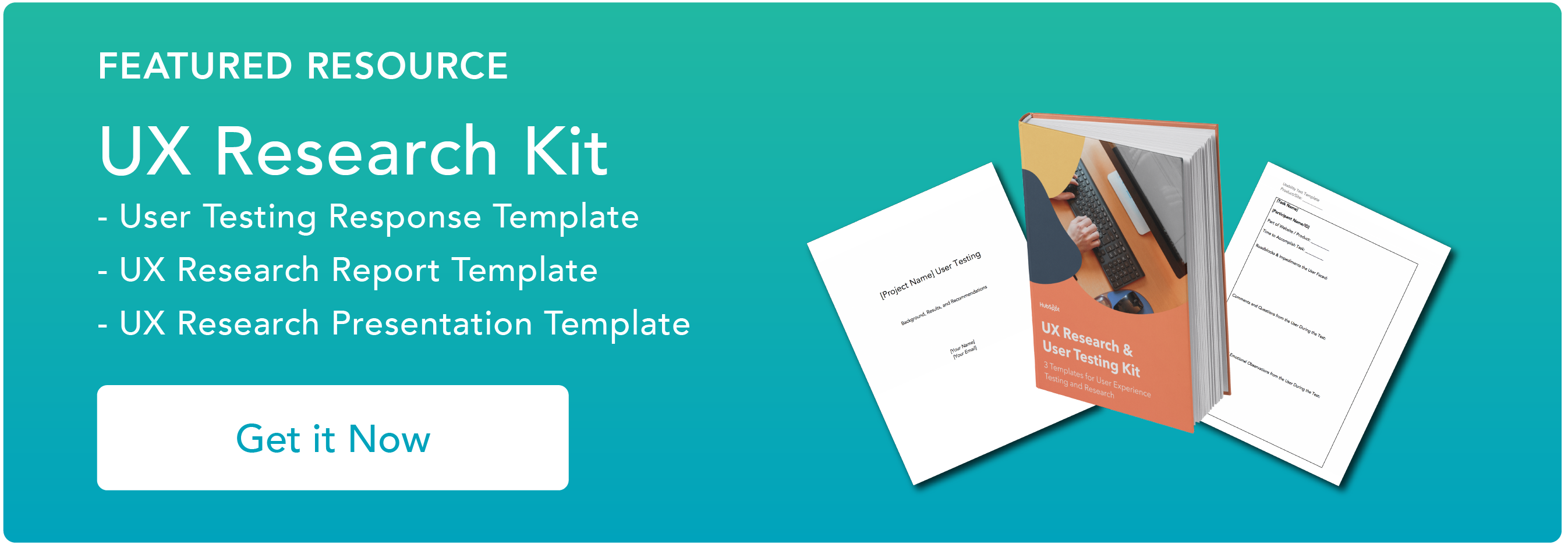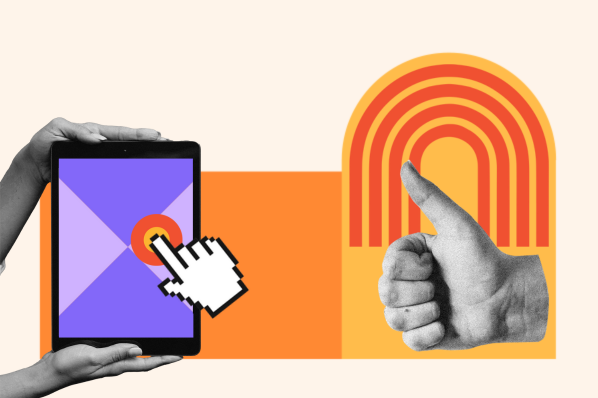The point? Getting UX right is critical to help keep potential customers engaged in the journey and move them along the pipeline from initial click to eventual conversion. The challenge? Developing and deploying a solid UX from scratch isn't easy.
In this piece, we'll highlight 18 great UX tools that can help enhance the user experience and increase your online impact. Let's get started.
What are UX tools, and why are they worth it?
Before we dive into our UX tools list, let's discuss what UX tools are in the first place. Simply put, UX tools are software that you use throughout the development and design process. There's one primary reason why UX tools are worth it: They can help your team better understand how the website (or app) they're building will serve users.
By building the use of UX tools into your workflow, your team can troubleshoot and solve problems before consumers experience them. And that's important because user experience can make or break a customer's decision to go with your brand or another.
Think of it this way — we encounter UX examples every day in real life. While we don't typically use this term to describe them, the processes and potential frustrations are identical.
Consider this picture of an entryway:

See the problem? While the flat metal pads suggest the doors should be pushed open, the sign on the right-hand door indicates that users must pull, despite the fact there's no way actually to accomplish that goal.
This is a classic case of bad UX design. Mixed messages and counterintuitive functions make it frustrating to look at this door, let alone attempt to open it. What is the most likely scenario for a potential visitor? Turning around and walking away — either to find another entrance or visit another business.
If the designers used UX tools and processes in the design process, they might have been able to determine that there was an issue, saving people stress and frustration.
For effective UX, there's an easy rule of thumb: It must be simple, clear, and accessible. UX tools help you make that possible.
The Three-Stage Approach to Better UX
When it comes to designing great digital UX, three stages are critical: Capture, creation, and confirmation. Let's dive into these unique stages and how they contribute to the larger goal of contributing exceptional user experiences.
- Capture stage: This stage is centered on user research — the process of collecting data about what potential customers want, what they don't, and where your UX needs to improve.
- Creation stage: This stage is all about design. Here, you're working to develop online UX that aligns with research data.
- Confirmation stage: This stage focuses on user testing to ensure your UX is working as intended, both from a purely functional standpoint and from the perspective of users interacting with your service or application.
All of these stages are invaluable and work together to accomplish your goal. Below we'll look at 18 UX tools that fall into these different stages.
The Capture Stage: UX Research Tools
1. User Interviews
.webp?width=650&height=338&name=Screenshot%202023-05-19%20at%2011.00.21%20AM%20(1).webp)
User Interviews is exactly what you'd expect: A tool that lets you conduct user interviews to discover what people want from your UX, and what they like (or don't) about your current user experience. This is one of the best UX tools because you also have the opportunity to gain suggestions about how you can make your UX better.
The tool boasts an available user audience of up to 400,000 vetted participants that can be targeted by geography, demographics, or other criteria, or you can bring your own users to the table.
Pricing: Pricing varies depending on if you want a Recruit or Research Hub account.
2. Dovetail

Dovetail is a cloud-based research platform that lets you capture and store everything from notes to transcripts to videos and audio recordings, then analyze this data repository for common trends you can use to improve UX. Because everything is in one central location, it's easy for your team to locate and use customer research. This encourages your internal team to maintain focus on user experience.
Pricing: You can access Dovetail for $50 per month along with a free trial of basic features.
3. Google Analytics

An oldie but a goodie, Google Analytics comes with big-time name recognition. There are a few reasons Google Analytics ranks on our list of the best UX tools, but the main one is that it has access to a massive amount of user data.
Google Analytics doesn't cost anything to use and can be leveraged to track key metrics such as bounce rates, traffic sources, and user demographics. This tool takes research beyond users' opinions to target user behavior and discover where, when, and why they're clicking through or leaving your site. Plus, it features an intuitive user interface, so getting started is quick and easy.
Pricing: Free
4. Airtable

With Airtable, you can quickly schedule and manage user interviews, collect feedback, and group user insights by common theme or keyword to help target critical concerns. Worth noting? Airtable offers many workflow and analytics functions beyond UX research, making it a great all-around tool for online businesses. Plus, it integrates with many of your other favorite tools, such as Google Drive, Asana, and Dropbox.
Pricing: Free options are available if you're just getting started with UX research, or you can upgrade to the Plus version of Airtable for $10 per month, per seat.
5. Dscout

Dscout comes with more than 100,000 potential research participants to recruit, and results are available in as little as 48 hours. This tool also prioritizes the value of unmoderated, one-to-one video research that lets your team see how users interact with your site or service in real-time. The result? You get a ground-floor view of where your site makes sense and where things aren't working as intended. We also love that this tool offers a variety of resources you can use to make beginning easy.
Pricing: To learn about pricing, you must contact Dscout directly.
The Creation Stage: UX Design Tools
6. Lucidchart

Lucidchart is a flowcharting tool that makes it easy to see how processes and features on your website connect. One main highlight of this tool is its easy-to-use drag-and-drop functionality along with real-time collaboration. You can also connect Lucidchart to other popular services, including GitHub or Microsoft Office. And since the solution is cloud-based, there are no restrictions on when or where you can design your next functional flowchart.
Pricing: If you're getting just started with UX design, you can edit three documents for free with Lucidchart or pay $7.95 for individual access.
7. Omnigraffle

Omnigraffle is designed specifically for iOS and Mac services that make it possible to create software and website mockups. While OS-agnostic tools are great for most design functions, there's a case to be made for iOS-specific UX, especially if this application framework is your priority. Apple users have very high expectations for their user experience — Omnigraffle helps ensure you're getting it right the first time. One highlight is how Mac, iPhone, and iPad share the same stencils, so you can work on your diagram anywhere.
Pricing: This UX tool comes with a 14-day free trial. After that, you can opt for a $12.49 per month subscription or pay $149.99 for a standard license.
8. Adobe XD

Adobe XD is a wireframing tool for both MacOS and Windows devices. It lets you create website wireframes, mockups, and prototypes in the same design file and comes with a minimalist interface that helps streamline the UX design process. There are plenty of tutorials available to help you get a better understanding of how to work with this tool.
Pricing: Adobe's starter plan is free and comes with 2GB of storage and one sharable prototype. For $9.99 per month, you can design and share unlimited prototypes with 100GB of cloud storage space.
9. Sketch

Sketch is another MacOS tool and high-quality wireframe tool. This lightweight vector design tool is iterative, and makes it easy for teams to design site or service wireframes quickly.
While the tool is fairly basic, it offers easy integration with other design tools, making it a great starting point for UX wireframe building. Plus, with the help of Sketch, prototyping is intuitive, you can work with shared libraries and even control color profiles. There are also new reusable design templates available that streamline the creation process.
Pricing: Sketch offers plans for $9 per month or $99 per year.
10. Axure

Axure empowers prototyping and makes it easy for your teams to keep track of UX design workflows. This solution takes the opposite approach to Sketch with full-featured and high-fidelity designs, functional testing, and easy developer handoff once prototypes are built. Because Axure offers dynamic content, it allows for more realistic UX prototypes. You can also add working forms with drag-and-drop technology.
Pricing: Along with a free trial, Axure offers Pro, Team, and Enterprise plans that include unlimited prototypes and reviews. The Team plan adds cloud hosting, while the Enterprise plan comes with a company domain for internal use.
11. FlowMapp

FlowMapp is all about sitemap design. Unlike some of the tools listed above that offer multiple functions in one package, FlowMapp focuses on creating a user journey that's simple, streamlined, and effective. Right now, FlowMapp offers Sitemap, User Flow, Personas, and Customer Journey Map solutions. Flowmapp is also a worthwhile tool because it appeals to people in an array of roles — everyone from developers to copywriters to UX strategists and project managers can benefit from using this UX tool.
Pricing: Pricing for FlowMapp starts with a free tier that includes one active project and 100MB of space, while its Pro Tier comes in at $18 per month. You can also opt for team ($54/month) or agency ($180/month).
The Confirmation Stage: UX Testing Tools
12. Google Optimize

Google Optimize is a free A/B testing tool that lets you easily evaluate how well your site is working. Once you've identified a webpage that needs improvement, the Optimize editor lets you make changes and run tests to see if these changes positively impact specific metrics.
Once you've completed your testing, you can use Google Optimize to go live with the version of your site that offers the best results. And remember how we mentioned Google Analytics before? The best part is that Google Optimize natively integrates with that tool, so accessing your data is easier than ever.
Pricing: Free
13. Survicate

Survicate is an intuitive yet powerful survey software, perfect for collecting continuous customer insights at scale and across multiple channels.
Measure customer satisfaction and product market fit effectively. Gather crucial feedback on your website, product, and mobile app with Survicate to better understand your customers' needs.
Pricing: Starts at $53/ month
14. Crazy Egg

Crazy Egg also offers A/B testing but is better known for its heat mapping function: Using visual reports that show where users are clicking through and navigating to the most, you can target areas of your site that aren't working as intended, then rerun heatmap tests to see if the changes were effective. This tool also features other techniques to determine how successful your website is, such as surveys and traffic analysis.
Pricing: Along with a 30-day free trial, Crazy Egg offers a host of plans from Basic to Enterprise. Their most popular Plus plan is $99 per month and covers 150,000 tracked pages, 75 snapshots, and 1,000 monthly recordings. However, you can get started for as little as $29/month once your trial is up.
15. Contentsquare

Formerly Clicktale, Contentsquare is about tracking and fixing site and service issues. The tool is designed to discover where, how, and why your application fails and help eliminate the root causes of the problem. By combining actual customer behavior and machine learning, Contentsquare can extrapolate likely actions and see where things aren't working as intended.
Pricing: If you're curious about Contentsquare's pricing, you'll have to contact their sales department to learn more.
16. Refiner

Refiner lets you close the customer feedback loop with customized surveys to discover what users like, what they don't, and what they want to see improved. With a focus on high-converting survey widgets, Refiner also helps increase the number of respondents who actually open and answer your survey to deliver a more comprehensive view of UX impact. Plus, Loop11 uses insights powered by GPT-4. You can also choose between moderated and unmoderated user testing, so whichever feels like a better fit for you can be enacted.
Pricing: Pricing starts at $79 per month (if you pay annually). If you want to take it a step further, you can get Refiner's Growth level subscription which is $199/month (if paid annually).
17. Loop11

Loop11 is all about usability testing and takes this approach to the next level with the ability to record audio and video of users actually interacting with your site. This type of feedback is invaluable. While it's one thing to analyze written survey data, actual interactions provide an unfiltered look at what users like — or don't — about your site.
Pricing: Pricing starts at $179 per month when billed annually.
18. HubSpot's Advanced Marketing Reporting
Get started with HubSpot's Customer Journey Analytics
Last (but certainly not least), dig into customer journey analytics reporting tools with HubSpot's Advanced Marketing Reporting. Using this tool, you can gain greater insight into how each customer interaction connects with revenue. You can also analyze conversion rates, the duration of time between steps, and make an ideal customer journey. With the help of this tool, proving your marketing's effectiveness has never been so easy. And if there are any gaps in effectiveness, you can go back to the drawing board with UX.
Pricing: Get a free demo.
UX: Making it Great
Great UX is the foundation of any successful site or service. Armed with the right tools, your business can ensure all aspects of your UX process — from data capture to creation and confirmation — are aligned to deliver the best possible experience for users.
Editor's note: This post was originally published in September 2021 and has been updated for comprehensiveness.
User Experience
.png?width=112&height=112&name=Image%20Hackathon%20%E2%80%93%20Square%20(10).png)



![How to become a UX designer, a step-by-step guide [expert tips]](https://53.fs1.hubspotusercontent-na1.net/hubfs/53/become-a-ux-designer-1-20240731-321437.webp)


![How to Add a Parallax Scrolling Effect to Your Website [Examples]](https://53.fs1.hubspotusercontent-na1.net/hubfs/53/scroll-Aug-11-2023-05-24-08-8793-PM.png)

![20 UX Design Examples Hand-Picked by Experts [With Analysis]](https://53.fs1.hubspotusercontent-na1.net/hubfs/53/ux-design-examples-1-20250404-8425368.webp)
